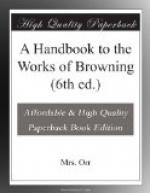“...
Off they steal—
How gently,
dawn-doomed phantoms! back come they
Full-blooded
with new crimson of broad day—
Passion
made palpable once more.” (P. 232.)
The revived passion may breathe under the name of another man; it may stir again in the utterance of one dead and forgotten; and Mr. Browning, borrowing the language of chemistry, invokes the reactive processes through which its many-coloured flamelets may spring to life.[136] He then passes by an insensible—because to him very natural—transition from the realities of feeling to those of thought, and to the underlying truth from which both series derive: and combats the idea that in thought, any more than in feeling, the present can disprove the past, the once true reveal itself as delusion. Time—otherwise growth—widens the range as it complicates the necessities of musical, i.e. emotional expression. It destroys the enfolding fictions which shield without concealing the earlier stages of intellectual truth. But the emotions were in existence before music began; and Truth was potentially “at full” within us when as it were reborn to grow and bud and blossom for the mind of man.[137] Therefore, he has said, addressing Avison’s March, “Blare it forth, bold C Major!” and “Therefore,” he continues, in a swift return of fancy:—
“...
Bang the drums,
Blow the
trumps, Avison! March-motive? That’s
Truth which
endures resetting. Sharps and flats,
Lavish at
need, shall dance athwart thy score
When ophicleide
and bombardon’s uproar
Mate the
approaching trample, even now
Big in the
distance—or my ears deceive—
Of federated
England, fitly weave
March-music
for the future!” (P. 237.)
The musical transformation is for a moment followed back to the days of Elizabethan plain-song, and then arrested at those of Avison, where he may be imagined as joining chorus with Bach in celebrating the struggle for English liberty. The closing stanzas are written to the music of Avison’s March, which is also given[138] at the end of the poem, and throws a helpful light on its more technical parts.
FUST AND HIS FRIENDS is based on a version of the Faust legend which identifies the inventor of printing with Dr. Faust, and contains allusions to some of the incidents of Goethe’s double poem: the magical drinking bout of the first part, and the appearance of the Grecian Helen in the second; but whereas the popular tradition makes Fust’s great discovery the fruit of his alliance with the powers of Evil, Mr. Browning represents it as an act of atonement for the figurative devil-worship which was involved in a disorderly and ostentatious life. Fust has by his own admission sinned to this extent.[139] He has obeyed the father of lies. He has also accepted




